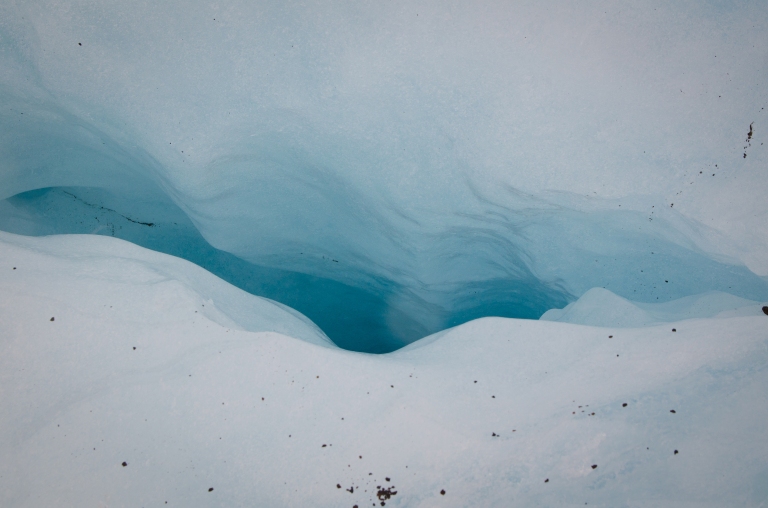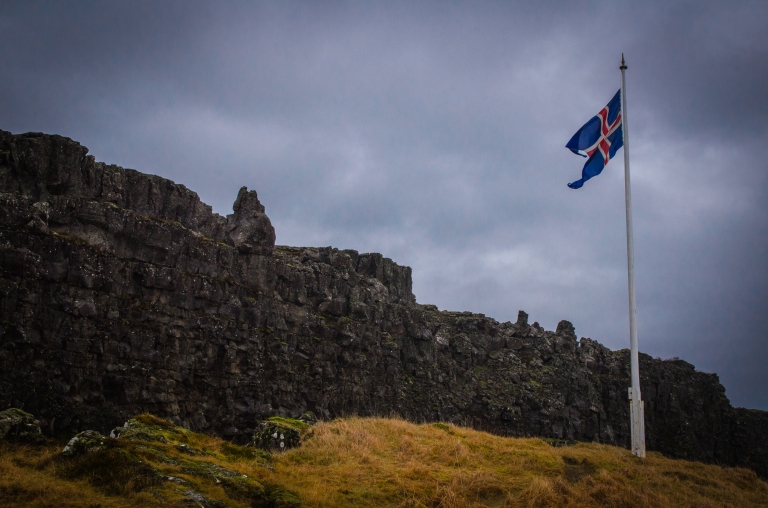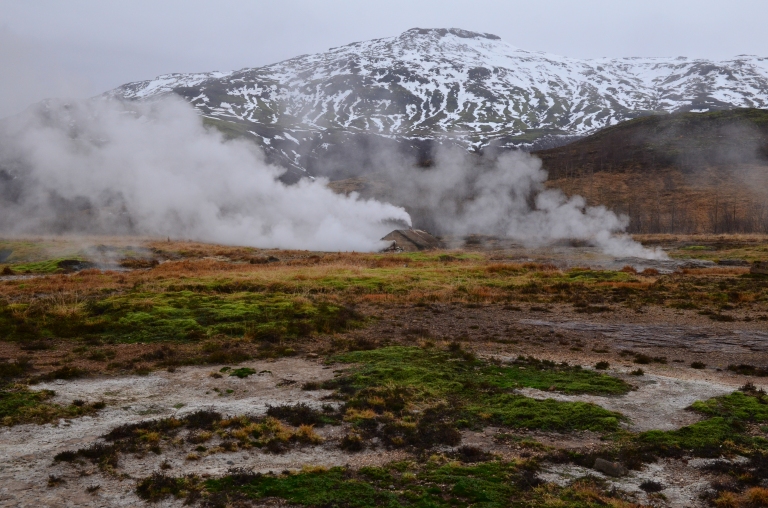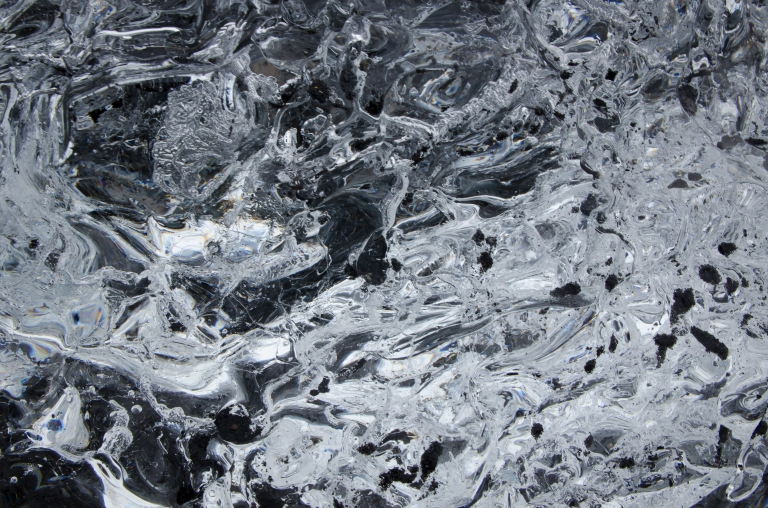Iceland…the land of fire and ice so they say. I must be honest, it wasn’t our most successful trip ever! It rained pretty much constantly which isn’t normal for February; someone said it’s the warmest February in 47 years! Normally, we’d take a bit of rain in our stride but unfortunately here the warmer, rainier, cloudy weather meant no snow, no blue skies, no Northern Lights and many splendid views enveloped in mist or even completely obscured. The first couple of days featured a storm which even the locals were taken aback by: the hazardous driving conditions kept us inside and our whale watching trip was sadly cancelled.
However, that’s not to say we didn’t enjoy ourselves! It’s a truly amazing country with breath-taking beauty around every twist and turn in the road.
Not only that, but the variety of landscapes is perpetually unexpected, bewilderingly so. One moment you are surrounded by moss-covered lava fields, the next snow-capped mountains alternate with blue-tinged glacial fingers. For a while, isolated farmsteads nestle into green hillsides, traced with glistening waterfalls but then soon jagged basalt cliffs drop steeply to black sand beaches. As you can imagine, the colours are vivid, the photographic opportunities plentiful. Some day we will return without the rain and see it all in its full splendour!
Hiring a car seemed the best option for us as we wanted to venture further than Reykjavik. Public transport is limited and organised tours are really not our cup of tea. Navigation was pretty easy as there aren’t that many roads and every conceivable tourist viewpoint or feature is well sign-posted, often with an explanatory information board. Below is a map of our week. Each day’s route is shown, in rainbow-colour order. We totalled about 2000km in all!
The freedom that came with hiring a car was perfect for us and, because the first one we were offered was mouldy, we complained and received an amazing upgrade to a 4×4 Suzuki Vitara complete with heated seats and its own satnav. Here it is:
I’ve decided to do this post a little differently. Instead of my usual chronological approach, we’ve put together our top ten favourite things about the week. Here they are in no particular order!
★ 1) Glaciers in Vatnajökull National Park
Iceland is home to several ice caps (11% of its area) – ancient snowy regions which have compressed into ice, crushing the ground below, sending glacial fingers creeping stealthily, determinedly through any available spaces between mountains. Vatnajökull is Europe’s largest ice cap by volume and we joined a five-hour Glacier Guides trek on one of its 30-ish outlet glaciers, Falljökull.
It was an incredible experience but one which I was rather dubious about given my current fitness level. Fortunately it was actually fairly easy going since the difficult terrain was inevitably a great leveller in terms of speed and we often paused to be given new safety instructions. Additionally, the requirement of the guides – Luke and Nick – to hack more definition into the ever-changing route resulted in regular rest stops.
We were also provided with heavy-duty hiking boots, crampons and an ice axe without which the hike would have been impossible.
We were surprised to learn that only a thin layer of mountain rock debris covered the ice, even from quite far away from the perceived beginning of the glacier.
One highlight was walking through a crevice. These are created when the ice – like flowing water – splits to fill the available space. A fall into one would be very dangerous if you weren’t expecting it which is why guides are compulsory.
Occasionally we came across small holes in the ice of indeterminable depth into which melt-water flowed. At this point we were warned of the consequences of falling into one! Not nice!
Most of the time, the only sounds piercing the silence were the crunch of crampons digging into the ice, but sometimes it was possible to hear melt-water flowing beneath the surface; cracking ice; and, twice, great chunks of glacier falling off in the distance!
All in all it was an awe-inspiring trip, realising how very small we are in comparison to nature’s powerful enormity!
We didn’t even really mind enduring five hours of rain! Vatnajökull was even more staggering when we flew over it on the way back to England.
★ 2) Þingvellir National Park
In 930, the Vikings established the world’s first democratic parliament, called the Alþingi, here at Þingvellir (Þ = Th). It’s a beautiful rift valley where the Eurasian and American tectonic plates meet, waterfalls abound and the river Öxará flows. This was our first stop on our Golden Circle day.
Since the original Viking settlers were self-governed, local chieftains (gođar) ran district assemblies (þings) where disputes could be resolved and justice administered. Individuals would then be responsible for enforcement, and often vengeance! Eventually the society began annual fortnight-long nationwide assemblies at this site which continued for over 300 years. A third of the country’s laws were delivered from memory by the law-speaker each year as there was no written language at this point. Crowds of thousands gathered on the plains around the law rock (Lögberg – possibly at the place now marked with a flag) to witness the law council pass laws, make decisions, confirm the calendar, form marriage contracts, and hand down judgments, all with the amplifying backdrop of the tectonic plate rock face.
Traders and entertainers joined the throngs; ale-makers brewed drinks for the guests; news from around the country was shared; punishments were watched; people looked for work; and banquets and games created a celebratory atmosphere. This unified assembly played a big part in the country’s history and helped shape its common cultural heritage and national identity.
Öxarárfoss waterfall is at the northern edge of the area and it flows into a pool called Drekkingarhylur (the Drowning Pool) where women guilty of crimes such as adultery or infanticide were drowned.
Other locations on the site give further ideas about punishments inflicted: witches and wizards were burnt at Brennugjá (Fire Gorge); beheadings occurred at Höggstokkseyri (Execution Block Spit); floggings happened at Kagahólmi (Whipping Islet); and people were hung for theft at Gálgaklettur (Gallows Rock).
★ 3) Great Geysir
The first sign that you are nearing another of the busy Golden Circle sights is the plumes of steam rising from fumaroles into the sky.
The second is the unmistakable stench of sulphur (think rotten eggs or stink bombs) that wafts towards you! Underfoot, trickling rivulets of magma-heated water cover the ground which is rainbowed by minerals, extremophile bacteria and algae.
All geysirs are named after one found here which reaches 80m when active.
However it’s currently dormant so doesn’t draw anything like as much attention as adjacent Strokkur. This one bubbles away then roughly every five minutes shoots up a huge jet of water before gurgling a little and settling back to a gentle simmer.
★ 4) Coastline
A number of times we detoured slightly to visit beaches. During summer an array of birds including puffins would be resident but we made do with kittiwakes.
To approach Djupalon (Black Lava Pearl) beach, we had to cross amazing Lord of the Rings-like terrain.
The beach is strewn with the remnants of a 1948 English trawler shipwreck from Grimsby, left there to commemorate the dead.
Here there is also a series of large stones, now lifted by tourists but originally used to test the strength of aspiring fishermen. From smallest to largest, the stones are referred to as Bungler (23kg), Weak, Half-Strong and Fully Strong (154kg). To be fit for life at sea, men needed to lift at lesat the 54kg Weak stone!
To photograph the harbour at Stykkisholmur, we risked life and limb on a terrifyingly windy ascent to the lighthouse!
The black sand and pebble beach at Reynisfjara featured an impressive cave and hexagonal basalt pillars like those on Northern Ireland’s Giant’s Causeway. There were also looming basalt sea stacks just off shore.
★ 5) Churches
In response to pressure from the Norwegian King Olaf, Christianity was adopted – without bloodshed – by the Icelandic population around AD 1000 at the annual Alþingi gathering. Previously, the country had been led by pagan chieftains, worshiping the old Norse gods like Óđinn, Þor, Freyr and Frigg and being buried with their possessions for the afterlife.
The church brought bells, priests in colourful clothing, mass, chanting, the altar and the concept of sin. Parish churches were built and many farmers also constructed and maintained small churches on their land to show their generosity and piety. For this, they received half the tithe but it was also a matter of pride to have a well-furnished church.
So now there are still little churches dotted here and there, often seemingly in the middle of nowhere.
And some much grander ones in more built-up areas.
★ 6) Accommodation
Blissfully unaware of how the weather would pan out back in November when I planned this trip, I selected four out of five of our guesthouses in the countryside to give us the best chance of seeing the aurora borealis. Although that side of things didn’t work out, we still enjoyed the picturesque isolation of these farmsteads. Here’s our favourite accommodation which was on the Snaefellsnes Peninsula:
We appreciated the interior design as well at a few of the places we stayed:
A few had kitchenettes too, meaning we could avoid the exorbitant food prices by eating cup noodles or cooking pasta. (You will notice food doesn’t make the top ten as we only ate out twice. Once was in a restaurant where we ordered two drinks, a sandwich, a soup and some fries for £42! The other was in a diner where for £25 we ordered two sandwiches, an enormous bowl of fries and took advantage of free vending machine hot drinks!)
★ 7) Jökulsárlón Glacier Lagoon

This was one of my absolute highlights of the week. Glimpsed from the road, we pulled up with a perfect view of the lagoon. It is an utterly surreal landscape of huge floating chunks of ice: smooth, jagged, rough, hollowed, twisted, in an array of blues and whites. The lagoon has been created by the retreat of another Vatnajökull glacier outlet over just the last 80 years. Icebergs calve from the glacier, drop into the lagoon then – taking up to five years – they float down Iceland’s shortest river and out to sea. Forgive the over-indulgence of photos: I was mesmerised!

Many of these icy boulders wash up on the beach where they eventually melt or get swept back into the sea.
But what absolutely made my day was a group of playful seals swimming, somersaulting and splashing about!

★ 8) Horses
I’m not sure why but there are stumpy, sturdy, little horses everywhere, usually gathered together, heads bowed against the cold, driving rain this week. Apparently the Vikings imported them because they were suited to the country’s tough conditions. I expected more sheep given the popularity of woolly jumper exports.
★ 9) Lava Fields
For sure the most other-worldly landscape we experienced was the lava fields. They’ve been there so long that each pinnacle of the bumpy, igneous terrain is covered in moss.
One of the Icelandic sagas (Eyrbyggja) describes a farmer who was sick of circumnavigating the lava field every time he wanted to visit his brother. He had hired two insanely violent Norwegian men (called berserkers) to work for him but one of them fell for the farmer’s daughter. As you might imagine, the farmer wasn’t too happy about that! Seeking advice from the local chieftain, the farmer discovered that this man was also interested in his daughter. They hatched a plan to set the berserker the impossible challenge of clearing a path through the lavafield in order to win his daughter’s hand. Unexpectedly, the berserkers succeeded. But, rather than keeping his word, the farmer trapped and murdered them, allowing the chieftain to may his daughter. A path through the Berserkjahraun lava field can be seen today and the grave of two large men was also discovered!
★ 10) Waterfalls
Out in the countryside, every couple of hundred metres it seems there’s fresh mountain water tumbling down a hillside. You can be sure there’ll be a little unsealed road leading to a parking area for even the smallest of these. The energy is often harnessed to provide power. On the Snæfellsnes Peninsula, this one – Kirkjufellsfoss – was near the base of Kirkjufell mountain:
Gulfoss is the largest and most famous waterfall and is one of the Golden Circle sights.
This one, with its hillside lost in the mist, we stumbled across on our journey along the south coast:
Finally, here are some things we’ve learnt about Iceland. We thought they were interesting so perhaps you will too.
★ Everyone’s surnames come from their father’s (usually) name plus ‘dóttir’ if they’re a girl and ‘son’ if they’re a boy. Consequently everyone is addressed by their first name and the phone book is organised by first names too. In addition, you must apply to the Icelandic Naming Committee if you wish to name your child anything which does not already appear on the official list of names.
★ Sagas form the basis of Icelandic history. They are – often violent and very dramatic – stories based on historical fact but with a sprinkling of mysticism, sorcery and exaggeration.
★ Due to being a relatively new settled land, Icelandic people can trace their history back to the days of the original settlers in 9th century with accuracy and in detail. The majority of people originally descend from Scandinavian fathers and British mothers because the settlers left Norway and Denmark, collecting British wives on their way to Iceland.
★ Back in 1703, Iceland became the first country in the world to conduct a census of the whole population by name. Of the 50,358 individuals counted, only about 1% were not farmers or farmworkers. Of these, 245 were clergymen and 142 were housemaids.
★ Over 2/3 of the population live in Reykjavik and its surrounds which is a really small proportion of the land. There are technically 30 ‘cities’ in the country but to earn this title there just has to be over 1000 inhabitants and in fact 19/30 have under 3000 residents. Perhaps because it’s winter, we felt we barely saw any Icelanders outside the tourist industry in the rest of the island.
★ Apparently most of the population will not categorically state that hidden races such as elves, fairies, lovelings, gnomes, mountain spirits and hidden people do not exist. Some people build elf houses and churches in their gardens although we didn’t see any.
Well that concludes our Icelandic wanderings. We will return!








































































































One thought on “Iceland: Winter Wanderings”